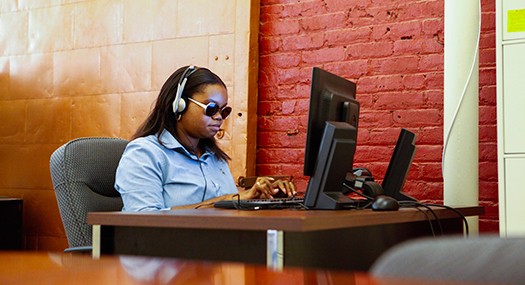In today's world, technology literacy and fluency is essential for employment, information exchange, learning, and economic and social activity. Beyond the classroom and workplace, it is also vital for accomplishing everyday tasks such as managing personal finances, shopping, monitoring health, and keeping up with news and popular culture. For people with vision loss, the digital information revolution has opened up previously unimaginable possibilities to become productive, independent, and fully integrated members of society. Specialized, assistive technology has been developed to allow people who are blind or visually impaired to participate in this revolution, and even mainstream consumer technology products increasingly include features that facilitate access by individuals with vision loss.
Yet, research shows that people with visual impairments lag woefully behind their sighted peers in acquiring the skills needed to take part in the technological revolution. Use of technology by people who are blind or visually impaired is much lower than for the general population, and lack of awareness, availability, and training opportunities contribute to this persistent gap. A recent study indicated that only 43% of students with vision loss use the Internet, compared with 95% of students without disabilities. And, another survey concluded that perhaps only 40% of students with vision loss who could benefit from using assistive technology were given opportunities to do so. Research also shows that teachers and professionals who work with people who are blind or visually impaired are often inadequately prepared to provide sufficient training in the use of assistive or mainstream technology. An astonishing 59% of teachers of students with visual impairments reported little or no comfort with teaching technology, according to a national study.
Kelly, S. M., & Wolffe, K. E. (2012). Internet use by transition-aged youths with visual impairments in the United States: Assessing the impact of postsecondary predictors. Journal of Visual Impairment & Blindness, 106(10), 597-608.
https://www.afb.org/afbpress/pubjvib.asp?DocID=jvib061004
- 43% of transition-aged youths were regular users of the Internet
- general population of teenagers aged 12 to 17, technology usage figures show that 93% use computers and 95% use the Internet.
Kapperman, G., Sticken, J., & Heinze, T. (2002). Survey of the use of assistive technology by Illinois students who are visually impaired. Journal of Visual Impairment & Blindness, 96 (2), 106-108.
- only 40% of students with vision loss who could benefit from using assistive technology were given opportunities to do so.
Zhou, L., Ajuwon, P. M., Smith, D. W., Griffin-Shirley, N., Parker, A. T., & Okungu, P. (2012). Assistive technology competencies for teachers of students with visual impairments: A national study. Journal of Visual Impairment & Blindness, 106 (10), 656-665.
- Research also shows that teachers and professionals who work with people who are blind or visually impaired are often inadequately prepared to provide sufficient training in the use of assistive or mainstream technology. An astonishing 59% of teachers of students with visual impairments reported little or no comfort with teaching technology, according to a national study.
